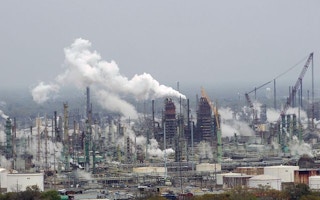Big oil is getting smaller. Many of the oil services companies that are employed when new fields are being developed have been laying off workers, and oil companies have been writing down their assets.
The problem is the persistent low price of oil. Despite the best efforts of OPEC − the organisation representing the developing world’s oil producing countries − to limit production and put a squeeze on supplies, oil prices have risen only slightly.
This has put many potential fields in the category of being too expensive to exploit − particularly in the case of the tar sands of Canada, and in the Arctic and difficult-to-reach offshore locations.
One of the areas where small fluctuations in the price of oil make a big difference is in the expansion of the fracking industry in North America, which led to the glut of oil on the world market.
Oil industry majors
The US, once the world’s biggest importer of oil, has increased home production so much that it now provides more than 75 per cent of its own oil. This has left OPEC countries looking for new customers.
The world’s oil field services companies, which rely on the oil industry majors such as Exxon, BP and Shell to employ them in exploiting new fields, have been shrinking as a result.
According to research by oil and gas consulting service Rystad Energy, about 300,000 people in the sector have lost their jobs between 2014 to 2016. That is about 35 per cent of the total workforce of the world’s top 50 oilfield services companies.
“
The race for the best hands and brains has started in the industry, and the companies that have laid off people in a responsible manner are likely to have a competitive edge going forward.
Audun Martinsen, vice president of oil field service research, Rystad Energy
It was the North American shale industry that took the largest single reduction, with two of the largest land drillers, Nabors Industries and Helmerich & Payne, announcing a series of staff cuts, resulting in an overall reduction of more than 50 per cent.
International companies that tend to be working on larger long-term projects took more modest cuts of between 20 per cent and 30 per cent, but these are still substantial.
The key to the future of many of these companies is what happens to the price of oil now. It had slumped to $40 a barrel before the latest OPEC production cut, then rose to nearly $60, before dropping back again to near $50.
The oil industry remains optimistic that these prices are short term, believing that the oil price will rise again above a threshold that makes investment in new fields worthwhile.
Oil and Gas Journal reported Audun Martinsen, Rystad vice-president of oil field service research, as saying that the North American companies were again recruiting more staff.
Rystad expects shale-focused operators to increase their spending by 30 per cent in 2017, while it thinks offshore spending will grow, beginning in 2018, as more final investment decisions are made.
“With more projects offshore being revived in 2017, we expect the offshore layoffs to stabilise and start to increase later in 2017,” Martinsen said. “Already we see this trend in Norway, and it is only a question of time before it starts elsewhere.
“The race for the best hands and brains has started in the industry, and the companies that have laid off people in a responsible manner are likely to have a competitive edge going forward.”
More efficient vehicles
However, outside the oil industry, commentators are not so sure. The constant expansion of the oil majors for more than a century has gone into reverse. The industry is suffering from competition from biofuels on one side and electric vehicles on the other.
Motor manufacturers have been forced by regulation to make vehicles more efficient, and expanding markets such as India and China are moving fast to cut pollution.
This has led to the Institute for Energy Economics and Financial Analysis (IEEFA) warning investors to get out of ExxonMobil shares.
It says the decline in the price of oil, from a maximum of $147 to around $50, leaves the company unable to cover the massive costs of operations and investment. The empire is bound to shrink, taking the price of shares down with it.
According to the International Business Times, the company may be in a “death spiral”. Quoting the IEEFA report, it says that while Texas-based Exxon Mobil may be considered the world’s largest oil company, there are danger signs about its future.
The company was established in 1990 after a merger of separate companies, Exxon and Mobil. In April, Standard & Poor’s Global Ratings service demoted ExxonMobil’s perfect AAA credit score to AA+ for the first time since the Great Depression of the 1930s.
Most recently, the company has come under fire as a result of what critics call a lack of transparency with regard to the value of its reserve in the face of oil industry woes and climate change.
The New York Attorney General, Eric Schneiderman, and the US Securities and Exchange Commission have both opened investigations into ExxonMobil’s accounting practices and how the company factored environmental change into its financial reporting.
This story was published with permission from Climate News Network.










